王磊&金伟&马天翼Angew:非贵金属气凝胶界面耦合高效选择性产HCOOH
电化学CO2还原(CO2RR)是缓解温室效应和能源危机的有效策略。它可以利用清洁的电能来固定空气中的CO2,并将其转化为高附加值的燃料和化学品。其中,无毒的甲酸作为一种液体产品,易于存储和携带,被认为是储氢和燃料电池的理想选择。然而,由于CO2的热力学稳定特性、多电子的反应途径和析氢反应(HER)的竞争,导致CO2RR转化效率较低,活化电位过大以及目标产物选择性差。因此,开发经济、稳定、高效的、选择性优异的 CO2 还原电催化材料是实现电化学 CO2 还原技术突破的命门。
近日,青岛科技大学王磊教授与吴则星特聘副教授、同济大学金伟教授和斯威本科技大学马天翼教授合作,以价格相对低廉的Bi和Sn为研究对象,设计了一种全新的非贵金属气凝胶,构建的三维多孔Bi-Sn气凝胶之间的界面耦合作用、电子相互作用等使其表现出优异的催化活性和选择性。
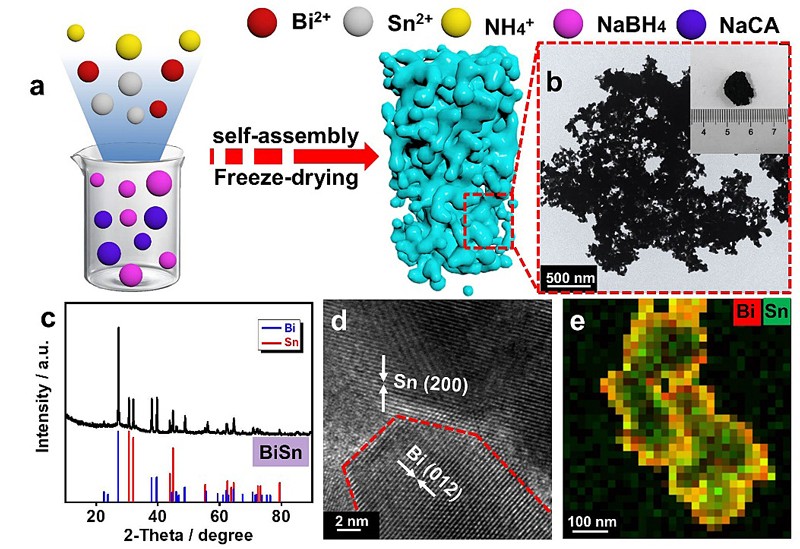
Figure 1. (a) Schematic illustration of the synthesis of Bi-Sn aerogel. (b) TEM image of Bi-Sn. (c) XRD patterns of Bi-Sn. High-resolution TEM image (d) sand corresponding elemental mappings (e).
所得到的Bi-Sn气凝胶甲酸产率高达93.9%,并且稳定的运行10 h,其显示出优秀的二氧化碳还原能力和选择性。究其原因:首先,纳米线随机地相互连接并形成具有丰富孔的网络形态,有利于电解质的运输,并在电催化过程中暴露出活性位点;其次,Sn和Bi之间存在着丰富的界面,可以在催化过程中充当反应中心;此外,优异的亲水性和电子相互作用对于提升催化性能也起到至关重要的作用。
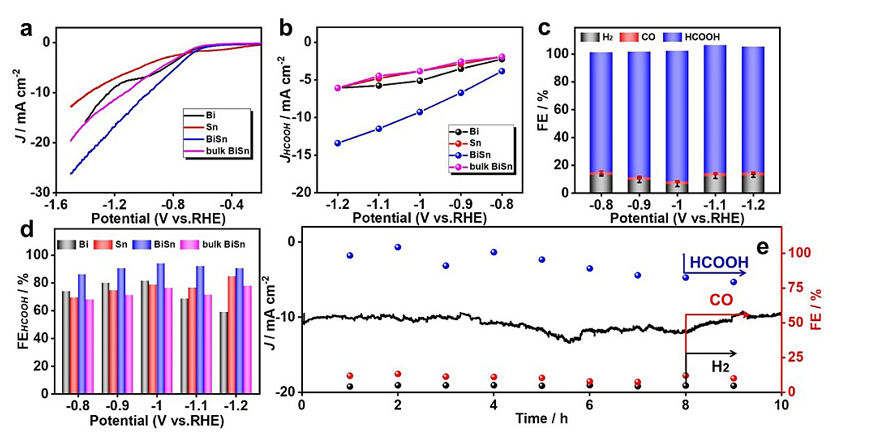
Figure 2. (a) LSVs of Sn, Bi, Bi-Sn and bulk Bi-Sn in CO2 saturated 0.1 M KHCO3. (b) Faradaic efficiencies of different products of the prepared Bi-Sn. (c) Comparison of formic acid Faradaic efficiencies of the prepared Bi, Sn, Bi-Sn and bulk Bi-Sn at various applied potentials. (d) Partial current densities for HCOOH of the designed various electrocatalysts. (e) Durability test of Bi-Sn in the flow cell configuration for 10 h.
通过原位红外分析发现* HCOO的形成是速率决定步骤。同时, DFT 理论模拟计算表明Bi-Sn结构可有效抑制析氢反应,有利于电化学反应的快速发生,从而有利于甲酸选择性的提高。
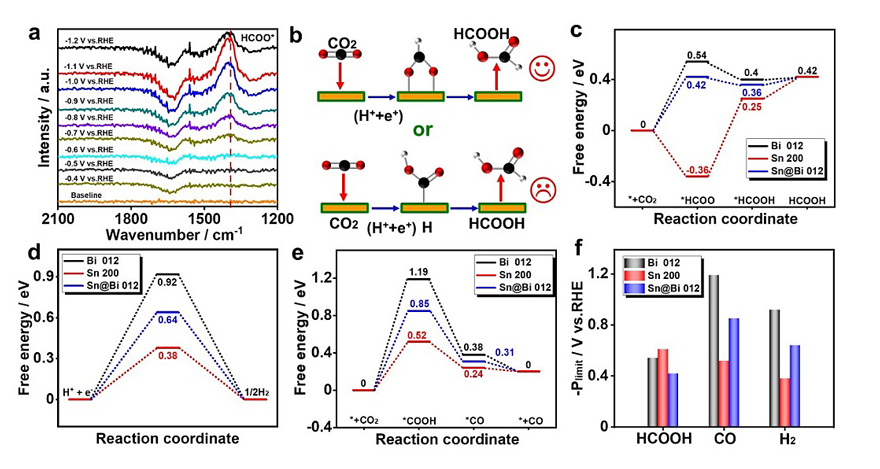
Figure 3. (a) ATR-FTIR spectra of Bi-Sn with various applied potentials. (b) Schematic illustration of the reaction mechanism for the generation of HCOOH. Calculated free energy change diagram for CO2 reduction to HCOOH (c), for HER (d) and CO process (e) on Sn 200, Bi 012, and Sn supported on Bi 012 surface. (f) Calculated limiting potentials for HCOOH, CO and H2 production on Bi 012, Sn 200 and Sn@Bi 012.
本研究所设计的纳米材料在二氧化碳还原中表现出出色的甲酸选择性和良好的循环稳定性。该工作为设计具有丰富的活性位点和通道的非贵金属气凝胶提供了一种新的策略。
原文(扫描或长按二维码,识别后直达原文页面,或点此查看原文):

Engineering Bi-Sn Interface in Bimetallic Aerogel with 3D Porous Structure for Highly Selective Electrocatalytic CO2 Reduction to HCOOH
Zexing Wu, Hengbo Wu, Weiquan Cai, Zhenhai Wen, Baohua Jia, Lei Wang*, Wei Jin*, Tianyi Ma*
Angew. Chem. Int. Ed., 2021, DOI: 10.1002/anie.202102832
导师介绍
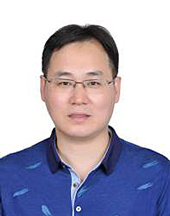
Lei Wang received his Ph. D in 2006 from Jilin University (supervisor: Prof. Shouhua Feng). Now, he is currently a professor in School of Chemistry and Molecule Engineering, Qingdao University of Science and Technologies (QUST). He was awarded as Distinguished Youth Scholar of Shandong Province and Young Taishan Scholar. His research interests mainly focused on energy-related fields, including electro/photochemistry, metal-organic chemistry and other energy-related fields. Until now, he has been published more than 180 papers on international journals and hosted more than ten foundations.
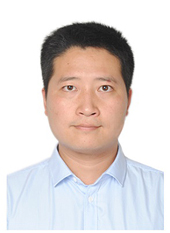
Wei Jin received the PhD degree with joint training of Institute of Process Engineering, Chinese Academy of Sciences (CAS) and University of Utah in 2012. After the postdoctoral training in Canada and United States, he started the faculty career as CAS Pioneer Hundred Talents Associate Professor in 2015. Now he is full professor at the School of Environmental Science and Technology, Tongji University since 2020. His research mainly focuses on Cleaner Electrometallurgy, and he was awarded ISE-Elsevier Prize for Green Electrochemistry in 2019.
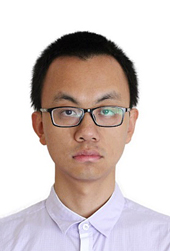
Tianyi Ma received his PhD in Physical Chemistry in 2013 from Nankai University, China. He then worked as a postdoctoral research fellow from 2013 to 2014 at University of Adelaide, Australia. He was awarded an Australian Research Council (ARC) Discovery Early Career Researcher Award (DECRA) in 2015, then worked as Lecturer and Senior Lecturer in Discipline of Chemistry at University of Newcastle. He joined Swinburne University of Technology in 2021 as Associate Professor, leading an independent research group focusing on functional materials for energy and environment related application such as photocatalysis, electrocatalysis, batteries and supercapacitors. He was named Global Highly Cited Researcher by Clarivate in 2020.
如果篇首注明了授权来源,任何转载需获得来源方的许可!如果篇首未特别注明出处,本文版权属于 X-MOL ( x-mol.com ), 未经许可,谢绝转载!












































 京公网安备 11010802027423号
京公网安备 11010802027423号